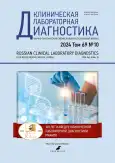Трансформация дополнительного профессионального образования специалистов лабораторной медицины. Анализ мнений специалистов клинико-диагностических лабораторий
- Авторы: Бугров А.В.1, Кузнецова Т.Е.1,2, Кисиличина Д.Г.1,3, Кашолкина Е.А.1,2, Ройтман А.П.1, Долгов В.В.1, Годков М.А.1,2
-
Учреждения:
- Российская медицинская академия непрерывного профессионального образования
- Научно-исследовательский институт скорой помощи им. Н.В. Склифосовского
- Московский многопрофильный научно-клинический центр им. С.П. Боткина
- Выпуск: Том 69, № 10 (2024)
- Страницы: 247-254
- Раздел: Обзоры
- Статья опубликована: 28.02.2025
- URL: https://kld-journal.fedlab.ru/0869-2084/article/view/646690
- DOI: https://doi.org/10.17816/cld646690
- ID: 646690
Цитировать
Полный текст
Аннотация
Обоснование. Дополнительное профессиональное образование обеспечивает соответствие квалификации сотрудника изменяющимся условиям работы и социальной среды, позволяет актуализировать знания и приобретать необходимые новые навыки. Для повышения качества образовательных услуг необходимо систематически анализировать запросы специалистов относительно обучения, однако унифицированная методика для решения данной задачи отсутствует.
Цель — оценить потребность специалистов клинической лабораторной диагностики в повышении квалификации.
Материалы и методы. В период с 25.10.2024 по 20.11.2024 гг. проведено анонимное онлайн-анкетирование 400 специалистов клинической лабораторной диагностики по вопросам повышения квалификации. Сбор голосов осуществлялся на добровольной основе. Опросник разработан с использованием сервиса Google Forms и состоял из 8 основных открытых и полузакрытых вопросов с единичным и множественным выбором. Результаты вносились в электронную базу данных с последующей обработкой с помощью программы Microsoft Office Excel 2018 и представлением в виде таблиц и графиков.
Результаты. В проведённом опросе приняли участие 400 специалистов в возрасте от 20 до 80 лет. Среди прошедших анкетирование 62% ( n =248) респондентов имеют высшее медицинское образование, 38% ( n =152) — высшее немедицинское образование. Стаж работы по специальности менее 5 лет у 10% ( n =40) респондентов, от 5 до 20 лет у 44% ( n =177), более 20 лет у 46% ( n =183). Подавляющее большинство, 95% ( n =382) опрашиваемых, заявили о работе в государственной лаборатории, 5% ( n =18) — в частной. Большая часть участников отдали предпочтение смешанному формату обучения — 41% ( n =164), 34% ( n =134) респондентов заявили о желании обучаться дистанционно, 25% ( n =101) — очно. Длительность повышения квалификации 144 ч и более выбрали 47% ( n =188) ответивших, 63% ( n =212) отдали предпочтение более коротким курсам. Финансировать собственное обучение готовы 16% ( n =62) респондентов, подавляющее большинство, 84% ( n =338), готовы учиться за счёт средств Федерального бюджета или средств организации, в которой они работают.
Заключение. Появление инновационных методик исследований, внедрение новых технологий, совершенствование нормативно-правовой базы — всё это диктует необходимость постоянного обучения и повышения квалификации, особенно в такой практико-ориентированной специальности как клиническая лабораторная диагностика. Содержание и формат программ повышения квалификации должны обновляться на регулярной основе в зависимости от потребностей специалистов.
Ключевые слова
Полный текст
Об авторах
Алексей Викторович Бугров
Российская медицинская академия непрерывного профессионального образования
Автор, ответственный за переписку.
Email: avb81@bk.ru
ORCID iD: 0000-0003-1404-4699
SPIN-код: 4321-6433
канд. мед. наук
Россия, МоскваТатьяна Евгеньевна Кузнецова
Российская медицинская академия непрерывного профессионального образования; Научно-исследовательский институт скорой помощи им. Н.В. Склифосовского
Email: tanyakuzya@inbox.ru
ORCID iD: 0009-0002-1063-9492
SPIN-код: 2927-6952
Россия, Москва; Москва
Дарья Григорьевна Кисиличина
Российская медицинская академия непрерывного профессионального образования; Московский многопрофильный научно-клинический центр им. С.П. Боткина
Email: kisilichina@mail.ru
ORCID iD: 0000-0002-5683-4931
SPIN-код: 6400-8278
канд. мед. наук
Россия, Москва; МоскваЕлена Александровна Кашолкина
Российская медицинская академия непрерывного профессионального образования; Научно-исследовательский институт скорой помощи им. Н.В. Склифосовского
Email: e.kasholkina@yandex.ru
ORCID iD: 0000-0002-9395-7578
SPIN-код: 4251-2731
Россия, Москва; Москва
Александр Польевич Ройтман
Российская медицинская академия непрерывного профессионального образования
Email: a-roitman@mail.ru
ORCID iD: 0000-0003-2592-6857
SPIN-код: 5400-7815
д-р мед. наук
Россия, МоскваВладимир Владимирович Долгов
Российская медицинская академия непрерывного профессионального образования
Email: vvdolgov@inbox.ru
ORCID iD: 0000-0002-6257-5024
доктор медицинских наук, профессор
Россия, МоскваМихаил Андреевич Годков
Российская медицинская академия непрерывного профессионального образования; Научно-исследовательский институт скорой помощи им. Н.В. Склифосовского
Email: mgodkov@yandex.ru
ORCID iD: 0000-0001-9612-6705
SPIN-код: 4871-6150
д-р мед. наук
Россия, Москва; МоскваСписок литературы
- Fedotov AV, Belyakov SA, Klyatchko TL, Polushkina EA. Periodical cycle of training for additional vocational education: facts and demands. University Management: Practice and Analysis. 2018;22(1):38–50. doi: 10.15826/umpa.2018.01.004
- Viktorov VV, Akhmerova SG, Nazarova EM, Khismatullina GYa. Organization of training of specialists for work in conditions of distribution of the new coronavirus infection COVID-19. Bashkortostan Medical Journal. 2020;15(3):40–44. (In Russ.) EDN: JZCHTQ
- Godkov MA, Dolgov VV, Roytman AP, et al. Interactive Professional Training of Specialists of the Clinical Laboratory Service in the Diagnosis of SARS-CoV-2. The Pedagogy of Professional Medical Education. 2021(4):65–77. (In Russ.)
- Zolotarev PN, Krasnova NN. Opinion of the Specialists with Higher Degree as a Criterion for Rating the Quality of Clinic-diagnostic Laboratories Work. Siberian Medical Journal. 2015;136(5):85–88. (In Russ.) EDN: VMGIDT
- Kulikova NYu. Online educational platform as a factor in the study of interactive learning technologies in a network environment. World of Science. Pedagogy and psychology. 2020;8(4):1–13. (In Russ.)
Дополнительные файлы












